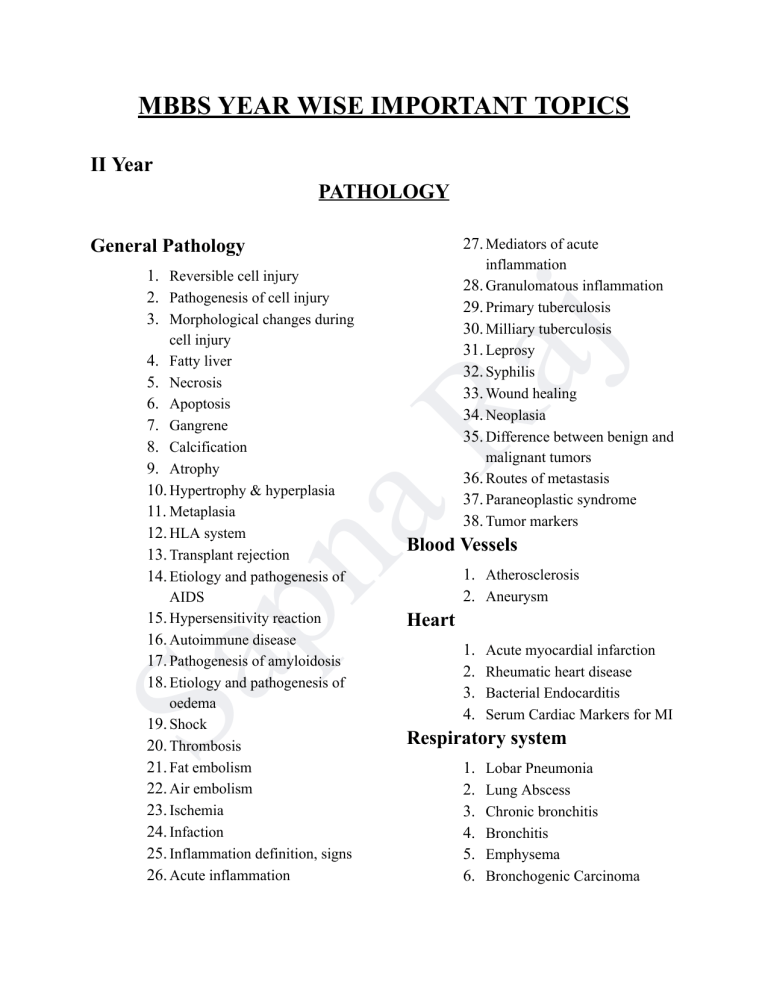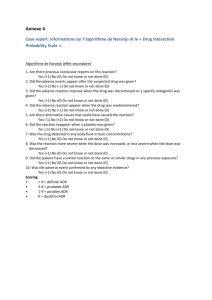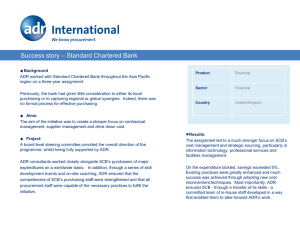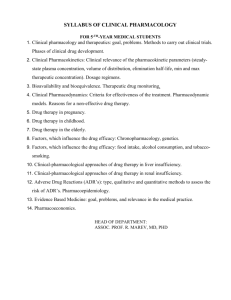MBBS Year 2 Important Topics: Pathology, Micro, Pharmacology
advertisement

MBBS YEAR WISE IMPORTANT TOPICS II Year PATHOLOGY 27. Mediators of acute General Pathology inflammation 28. Granulomatous inflammation 29. Primary tuberculosis 30. Milliary tuberculosis 31. Leprosy 32. Syphilis 33. Wound healing 34. Neoplasia 35. Difference between benign and malignant tumors 36. Routes of metastasis 37. Paraneoplastic syndrome 38. Tumor markers Ra j 1. Reversible cell injury 2. Pathogenesis of cell injury 3. Morphological changes during Sa pn a cell injury 4. Fatty liver 5. Necrosis 6. Apoptosis 7. Gangrene 8. Calcification 9. Atrophy 10. Hypertrophy & hyperplasia 11. Metaplasia 12. HLA system 13. Transplant rejection 14. Etiology and pathogenesis of AIDS 15. Hypersensitivity reaction 16. Autoimmune disease 17. Pathogenesis of amyloidosis 18. Etiology and pathogenesis of oedema 19. Shock 20. Thrombosis 21. Fat embolism 22. Air embolism 23. Ischemia 24. Infaction 25. Inflammation definition, signs 26. Acute inflammation Blood Vessels 1. Atherosclerosis 2. Aneurysm Heart 1. Acute myocardial infarction 2. Rheumatic heart disease 3. Bacterial Endocarditis 4. Serum Cardiac Markers for MI Respiratory system 1. Lobar Pneumonia 2. Lung Abscess 3. Chronic bronchitis 4. Bronchitis 5. Emphysema 6. Bronchogenic Carcinoma 7. Bronchial Asthma 7. Intestinal TB Liver Endocrine 1. Liver Function test 2. Jaundice 3. Neonatal Jaundice 4. Viral Hepatitis 5. Acute Hepatitis 6. Cirrhosis 7. Alcoholic Liver Disease 8. Biliary Cirrhosis Kidney 1. Functions of Thyroid 2. Thyroid Function Test 3. Hashimoto's Thyroiditis 4. Goiter 5. Toxic Goiter 6. Grave's Disease 7. Lab diagnosis of DM 8. Glycosylated Hb 1. Renal function Test 2. Nephrotic syndrome 3. Nephritic syndrome 4. Acute pyelonephritis 5. Chronic pyelonephritis 6. Wilms Tumor 7. Acute post streptococcal Ra j CNS Skin Sa pn a Glomerulonephritis 8. Non streptococcal Glomerulonephritis 9. RPGN 10. Minimal Change Disease 11. Membrano proliferative Glomerulonephritis 12. Ig A Nephropathy 13. Diabetic Nephropathy 14. Hydronephrosis 1. Berry Aneurysm 2. Cerebral infarction 3. CSF examination 4. Neuroblastoma Git 1. Gastritis 2. Peptic ulcer 3. Difference between Gastric and Peptic ulcer 4. Gastric carcinoma 5. Inflammatory Bowel Disease 6. Enteric Fever 1. Basal Cell Carcinoma 2. Premalignant Lesions Breast 1. Fibroadenoma 2. Cancer of Breast MICROBIOLOGY 14. Alternative pathway of General Microbiology complement system 15. Hypersensitivity reaction and its types 16. anaphylactic reaction [type 1 hypersensitivity reaction) 17. Type 2 hypersensitivity 18. arthus reaction 19. serum sickness 20. Delayed hypersensitivity reaction Ra j 1. koch's postulate 2. Bacterial Cell wall 3. Flagella 4. Bacterial Spore 5. Bacterial growth Curve 6. Methods of sterilization 7. Hot Air oven 8. Pasteurisation of milk 9. Autoclave 10. sterilization by radiation and Bacteriology Sa pn a halogens 11. Types of media. write in detail about indicator media 12. Anaerobic methods 13. Anaerobic Media 14. Gene transfer Immunity 1. Innate immunity 2. Difference between active and passive immunity 3. Antigen and Factors of antigenicity 4. Structure of immunoglobulin 5. Ig G 6. Ig M 7. Ig A 8. Precipitation Reaction 9. Agglutination Test 10. Coombs Test 11. Complement fixation test 12. Elisa and its types 13. Classical pathway of complement system 1. Staphylococcus 2. streptococcus 3. pneumococcus 4. Neisseia 5. Corynebacterium diphtheria 6. Bacillus 7. Clostridium perfringens 8. Clostridium Tetani 9. E.coli 10. Salmonella typhi 11. Shigella 12. Pseudomonas 13. Vibrio 14. Mycobacterium Tuberculosis 15. Mycobacterium Lepra 16. Spirochaetes Virology 1. Difference between Virus and Bacteria 2. Describe structure and chemical nature of a virus 3. process of viral replication Mycology 7. Taenia Solium and Taenia Saginata 8. Echinococcus Granulosus 9. S. haematobium 10. Ascariasis Lumbricoides 11. Ancylostoma Duodenale 12. Trichuris Trichiura 13. Enterobius Vermicularis 14. Wuchereria Bancrofti 15. Dracunculus medinensis Ra j 4. Cultivation of virus 5. Types of viral cell culture 6. Inclusion Bodies 7. Bacteriophages 8. Herpes simplex virus 9. Varicella Zoster Virus 10. Cytomegalovirus 11. Epstein Barr Virus 12. Influenza Virus 13. Measles Virus 14. Dengue Virus 15. Rabies Virus 16. Hepatitis A 17. Hepatitis B 18. Hiv Virus 19. Rota virus 20. Polio Virus Sa pn a 1. Difference between Fungi and Bacteria 2. Classification of Fungi 3. Laboratory Diagnosis of Fungal Disease 4. Dermatophytes 5. Mycetoma 6. Candidiasis 7. Cryptococcosis 8. histoplasmosis 9. Aspergillosis Parasitology 1. Entamoeba Histolytica 2. Giardia Lamblia 3. Trichomonas Vaginalis 4. Leishmania donovani 5. Plasmodium 6. Toxoplasma Gondii PHARMACOLOGY 6. Write in detail about Atropine General Pharmacology 1. Routes of drug administration 2. Drug absorption and factors Ra j affecting it 3. Bioavailability 4. Plasma Protein binding 5. Biotransformation 6. Microsomal Enzyme Induction 7. Excretion 8. G Protein coupled Receptor 9. Synergism 10. Drug antagonism 11. Factors Modifying Drug Action 12. Adverse Drug Reaction 13. Teratogenicity 14. Tachyphylaxis substitutes 7. Classification of an adrenergic agonist. Describe Mechanism of action, Pharmacological Base, Therapeutic Uses and Adverse drug reaction of Adrenaline 8. Difference between dopamine and dobutamine 9. Classification of Alpha blockers. Describe their Mechanism of action, Pharmacological Base, Therapeutic uses and Adverse drug reactions. 10. Classification of Beta Blocker. Describe Mechanism of action, Pharmacological Base, Therapeutic Uses and adverse drug reaction of Propranolol 11. Describe the Drugs used in glaucoma. Write in detail about the pharmacological base of using different drugs in open angle glaucoma. Sa pn a ANS 1. Classification of Cholinergic drugs. Describe about Mechanism of action, Pharmacological base, Uses and adverse effects of Neostigmine 2. Myasthenia Gravis 3. Pilocarpine its mechanism of action, Uses and ADR 4. Organophosphate Poisoning. Its clinical manifestation and treatment 5. Classification of anticholinergic Drugs. Describe Mechanism of action , Pharmacological base, Therapeutic uses and adverse effects of Atropine Autacoids 1. Classification, Pharmacological action , uses and ADR of H1 antagonist 2. Drug therapy for migraine 3. prophylaxis of migraine 4. Uses and side effects of prostaglandins 5. Classification of NSAIDS 6. MOA, Uses, Side effects and 6. Classification of Anti anginal contraindication of Aspirin 7. Ibuprofen - Uses, Side effects 8. Diclofenac Sodium - MOA, Uses, ADR 9. Paracetamol - Uses, ADR, Poisoning 10. Classification of Drugs Used in Gout. Write in detail about Probenecid or Allopurinol Drugs. Pharmacological Action, Uses and ADR of GTN. 7. Treatment of CCF 8. Treatment of MI 9. Classification of Antiarrhythmic Drugs 10. Potassium Channel Opener. 1. Classification of Drugs for Ra j Respiratory System Kidney CNS Sa pn a Cough. write in detail about Dextromethorphan 2. Classification of drugs used in bronchial Asthma 3. Salbutamol or B2 Agonist in asthma 4. Methylxanthines 5. Mast Cell Stabilizer/ Sodium cromoglycate 6. LT antagonist 7. Inhaled steroids in asthma 1. Classification of Diuretics 2. Furosemide/ Loop Diuretics 3. Thiazides 4. Spironolactone 5. Osmotic Diuretics / Mannitol CVS 1. Classification of Anti hypertensive 2. Treatment of Hypertension 3. ACE inhibitors/ Pharmacological Action, Uses and ADR of Captopril 4. ARB / Pharmacological Action, Uses and ADR of Losartan. 5. Calcium Channel Blocker / CCB/ Nifedipine 1. Classification of General Anesthetics 2. Stages of Anesthesia 3. Nitrous oxide 4. Halothane 5. Thiopentone Sodium 6. Preanesthetic Medication 7. Methyl alcohol poisoning 8. Classification of sedative drugs. 9. Benzodiazepines/ Diazepam 10. Classification of Antiepileptic Drugs 11. Phenytoin 12. Carbamazepine 13. Sodium Valproate 14. Status Epilepticus 15. Classification of 5. Classification of Antiemetic Antiparkinson's Drugs.Pharmacological Action, Uses and ADR of Levodopa 16. Classification of Antipsychotic Drugs. Pharmacological Action, Uses and ADR of Chlorpromazine 17. Classification of Antidepressant Drugs. Pharmacological Action, Uses and ADR of SSRIs. 18. Classification of opioids. Pharmacological Action, Uses and ADR of Morphine. 19. Difference Between morphine and pethidine Drugs 6. Metoclopramide 7. Ondansetron/ 5HT3 Antagonist 8. GERD 9. Classification of Drugs used in diarrhea. 10. Pharmacological Action, Uses and ADR of ORS. 1. Classification of Antithyroid Sa pn a 1. Oral Iron therapy 2. Parenteral iron therapy 3. Classification of Ra j Blood Endocrine Anticoagulants. Pharmacological Action, Uses and ADR of Heparin 4. LMWH 5. Difference between Heparin and Warfarin 6. Oral Anticoagulants/ Warfarin 7. Antiplatelet Drugs/ Aspirin 8. Fibrinolytics/ Streptokinase/ Urokinase 9. Hypolipidemic Drugs GIT 1. Classification of Drugs and Treatment of peptic Ulcer 2. H2 Antagonist 3. Proton Pump Inhibitors 4. Anti H pylori Drugs drugs. Moa, Uses and Adr of propylthiouracil. 2. Thyroid storm 3. Insulin analogue uses and adr 4. Diabetic Ketoacidosis 5. Oral hypoglycemic drugs classification Moa, uses and adr of sulfonylureas. 6. Biguanides 7. Classification, uses and Adr of Glucocorticoids 8. Finasteride 9. Mifepristone 10. HRT 11. Types of Contraceptive methods and write in detail about Oral contraceptive pills 12. classification Uterine Stimulants Moa, uses and adr of Oxytocin Antimicrobials 1. Antibiotic Resistance 2. Classification of sulfonamides, MOA, Uses, Adr 3. Cotrimoxazole 4. Classification of 17. Treatment therapy of complicated malaria. Sa pn a Ra j fluoroquinolones. MOA, Uses, Adr of ciprofloxacin 5. Classification of Beta lactam antibiotics. MOA, Uses, Adr of penicillin 6. Classification of cephalosporins. MOA, Uses, Adr. 7. Classification of Broad spectrum antibiotics. MOA, Uses, Adr of Tetracyclines 8. Classification of Macrolides. MOA, Uses, Adr of Erythromycin. 9. Classification of antitubercular drugs. MOA, Uses, Adr of Rifampicin. 10. Classification of antileprosy drugs. MOA, Uses, Adr of Dapsone. 11. Classification of Anti Hiv drugs. MOA, Uses, Adr of NRTI. 12. Post exposure prophylaxis of HIV 13. Classification of antiamoebic drugs. MOA, Uses, Adr of Metronidazole. 14. Classification of antiparasitic drugs. MOA, Uses, Adr of Albendazole. 15. Classification of Antifungal drugs. Moa, uses and Adr of Amphotericin B. 16. Classification of Antimalarial drugs. MOA, Uses, Adr of Chloroquine III YEAR ENT 6. Chronic tonsillitis 7. Ludwing’s angina 8. Quinsy 9. Pharyngeal pouch Ear Nose 1. Lateral wall of nose 2. Nasal septum 3. Rhinophyma 4. Saddle nose 5. DNS 6. Septal haematoma 7. Perforation of Nasal septum 8. Viral rhinitis 9. Rhinoscleroma 10. Rhinosporidiosis 11. Foreign body 12. Rhinolith 13. Maggots 14. CSF rhinorrhea 15. Nasal polyp 16. Epistaxis 17. Atrophic rhinitis 18. Allergic Rhinitis 19. Fracture of maxilla 20. Acute Maxillary sinusitis 21. Oral cavity 22. Oral submucous fibrosis 23. Leukoplakia and erythroplakia 24. Carcinoma of tongue Ra j 1. Tympanic membrane 2. Middle ear 3. Inner ear 4. Physiology of hearing 5. TFT 6. Presbycusis 7. BPPV 8. Furuncle 9. Foreign body in ear 10. Eustachian tube 11. Acute suppurative otitis media 12. Otitis media with effusion 13. Chronic suppurative otitis Sa pn a media 14. Mastoditis 15. Facial nerve anatomy 16. Bell’s palsy 17. Otosclerosis 18. Meniere's disease 19. Acoustic Neuroma 20. Cochlear implant Pharynx 1. Waldayer’s ring 2. Adenoid facies 3. Juvenile nasopharyngeal angiofibroma 4. Tonsil anatomy 5. Acute tonsillitis 6. Laryngocele 7. Cancer of larynx 8. Hoarseness 9. Tracheostomy Larynx & Trachea 1. Muscle of larynx 2. Acute epiglottitis 3. Laryngomalacia 4. Recurrent laryngeal nerve paralysis 5. Vocal nodules Errors of Refraction 1. Cataract 2. Congenital cataract 3. Senile cataract 4. Complicated cataract Glaucoma Sa pn a 1. Hypermetropia 2. Aphakia 3. Myopia 4. Astigmatism 5. Presbyopia 6. Lasik Ra j OPHTHALMOLOGY Conjunctiva 1. Acute bacterial conjunctivitis 2. Trachoma 3. Ophthalmia neonatorum 4. VKC 5. Pterygium Cornea 1. Layers of cornea 2. Bacterial Corneal Ulcer 3. Hypopyon corneal ulcer 4. Fungal corneal ulcer 5. Herpes simplex keratitis 6. Herpes zoster ophthalmicus 7. Uvea 8. Uveitis 9. Iridocyclitis Lens 1. Glaucoma def. 2. Primary open angle glaucoma 3. Angle closure glaucoma Retina 1. CRAO 2. CRVO 3. Hypertensive retinopathy 4. Diabetic Retinopathy 5. Retinitis pigmentosa 6. Retinal detachment 7. Tumors of retina/ retinoblastoma Neuro Ophthalmology 1. Optic neuritis 2. Amblyopia Ocular motility 1. Diplopia 2. Paralytic squint Eyelids 1. Xerophthalmia 1. Cut section of eyelid 2. Stye 3. Chalazion 4. Entropion Others 1. Steroids 2. Marcus Gunn pupil 3. Eye donation 4. Vision 2020 5. Ptosis 6. Phacoemulsification 7. Keratoconus 8. Ocular manifestation of eye in 1. Dry eye 2. Structure of tear film 3. Chronic dacryocystitis 4. Acute dacryocystitis 5. Congenital dacryocystitis Ocular injuries 1. Sympathetic ophthalmitis Sa pn a Systemic ophthalmology case of diabetes mellitus Ra j Lacrimal apparatus COMMUNITY MEDICINE (PSM) 17. Live vaccine 18. Dependency ratio Concept of Health and Disease Demography and family planning 1. Demographic cycle 2. IUDS 3. Hormonal contraceptives 4. MTP 5. Rhythm method 6. Eligible couples 7. Target couples 8. Advantage and disadvantage of Ra j 1. Definition of health 2. Iceberg of disease 3. Epidemiological triad 4. Levels of prevention 5. Modes of intervention 6. Dimensions of health 7. Physical Quality of health index 8. DALY 9. Disability rates 10. Millenium development goal 11. Primary health care 12. Types of disinfection 13. Health education principle Sa pn a Principles of Epidemiology and Methods 1. Definition of epidemiology 2. Case control study 3. Cohort study 4. Difference between case control and cohort study 5. Investigation of epidemic 6. Carrier 7. Modes of transmission 8. Vector borne transmission 9. Randomized control trials 10. Measurement of mortality 11. Measurement of morbidity 12. Immunization schedule of india 13. Cold chain 14. Vaccine vial monitor 15. Herd immunity 16. Incubation period condom 9. Sex ratio 10. Dependency ratio 11. Fertility 12. Pearl index 13. Emergency contraception Nutrition and Health 1. Visible and invisible fats 2. Vitamin A 3. Balanced diet 4. PEM 5. Mid day meal programme 6. Food fortification 7. Pasteurization of milk 8. Waterborne diarrhea Medicine and social science 1. Culture, acculturation and social stress 2. Intelligent quotient 3. Family 4. Types of family 5. Doctor patient relationship 6. Consumer protection act 1. Pneumoconiosis 2. Lead poisoning 3. Occupational hazards of Environment and Health agricultural workers 4. Sickness absenteeism 5. Medical measures to control occupational disease 6. The factories act 1. Safe and wholesome water 2. Sanitary well 3. Waterborne disease 4. Purification of water on large Charts and diagrams Ra j 1. Pie charts 2. Line diagram 3. Standard deviation 4. Standard normal curve 5. Sampling methods Communication Education Sa pn a scale 5. Disinfection 6. Chlorination 7. Purification of water on small scale 8. Air pollution 9. Prevention and control of air pollution 10. Types of ventilation 11. Effects of noise pollution 12. Biological effects of radiation 13. Overcrowding 14. Sanitation barrier 15. Sulabh sauchalaya 16. Culex and aedes mosquito 17. Mosquito control measures 18. Lice 19. Ticks and mites 20. Cyclops Hospital waste management 1. Definition 2. Health hazards of health care waste 3. Categories of biomedical waste in India 4. Color coding and types of container for disposal of bio medical waste Occupational Diseases for Health 1. Types of communication 2. Health communication 3. Principles of health education 4. Practice of health education Screening for disease 1. Difference between screening and diagnostic test 2. Validity for screening test 3. Sensitivity and specificity of screening Epidemiology of communicable disease 1. Measles vaccination 2. Rubella prevention 3. Prevention and control of swine flu 4. DPT vaccination 5. Prevention of meningococcal 13. Prevention of road traffic Accidents Health Programmes in india 1. API 2. National leprosy eradication programme 3. RNTCP 4. National Aids control programme 5. Vision 2020 6. Universal immunization programme 7. National Rural health mission 8. ASHA Reproductive and child health programme 9. Janani suraksha Yojana 10. Integrated management of neonatal and childhood illness ( IMNCI ) 11. Adolescent Health programme (WIFS) 12. National Mental Health programme Sa pn a Ra j meningitis 6. Acute respiratory infections 7. DOTS 8. DOTS plus 9. BCG vaccination 10. Polio vaccination IPV and OPV 11. Pulse polio immunization 12. AFP surveillance 13. Prevention of Hepatitis B 14. Oral rehydration therapy 15. Control of typhoid fever 16. Vector of malaria 17. Measurement of malaria 18. Prevention of human rabies 19. Immunization of dogs 20. Types of tetanus 21. Prevention of tetanus 22. Multidrug therapy for leprosy 23. ARV treatment 24. Post exposure prophylaxis of HIV 25. Standard precautions Epidemiology of Non communicable Disease 1. Risk factors of CHD 2. Prevention of CHD 3. Rule of halves in Hypertension 4. Risk of Hypertension 5. Prevention of Hypertension 6. Prevention of Rheumatic disease 7. Causes of cancer 8. Cancer Screening 9. Screening of DM 10. Prevention and care of DM 11. Assessment of Obesity 12. Prevention of blindness Preventive Medicine in obstetrics Pediatrics 1. Antenatal Care 2. Intranatal care 3. Neonatal care 4. Low birth weight kangaroo mother care 5. Baby friendly hospitals initiatives 6. Growth chart 7. Maternal mortality rate 8. Perinatal mortality rate 9. Neonatal mortality rate 10. Infant mortality rate 11. Under 5 mortality rate 12. School health service 13. Battered baby syndrome 14. Integrated child development 8. Functions of Medical officer at PHC 9. Health worker female functions 10. Health worker male functions service 15. Health of adolescents Disaster Management International Health 1. Disaster Management Cycle 2. Man made disasters 1. WHO 2. UNICEF 3. Indian Red Cross Genetics and health Ra j 1. Klinefelter syndrome 2. Turner syndrome 3. Genetic disease 4. Eugenics 5. Genetic counseling Mental Health 1. Characteristics of mentally Sa pn a healthy person 2. Warning signals of poor mental health 3. Alcoholism and drug dependence 4. Symptoms of drug addiction Health planning management and 1. Planning cycle 2. Bhore committee 3. Panchayati Raj Health care of the community 1. Primary health care Definition, principles 2. Millennium development goals 3. Health status and problems 4. Local dais 5. Anganwadi worker 6. Functions of PHC 7. CHC FORENSIC MEDICINE Chapter 1 1. Burn def. classification, factors affecting 2. Difference between antemortem and postmortem burn 3. Heatstroke 4. Electrical injury Chapter 10 Ra j 1. Inquest and its types 2. Summons 3. Dying declaration Chapter 2 1. Function of indian medical council 2. Types of courts 3. Duties of registered medical practitioner 4. Professional secrecy 5. Privileged communication 6. Medical negligence 7. Consent types 8. Euthanasia Chapter 3 1. Gustafson's technique 2. Dactylography 3. Poroscopy 4. Scars - Tatto marks Chapter 4 1. Brain death vs brainstem death 2. Algar mortis 3. Postmortem lividity 4. Rigor mortis 5. Mummification Chapter 5 1. Exumption 2. Preservation of viscera in case of poisoning Chapter 6 1. Abrasion 2. Bruise 3. Laceration 4. Stab wound 5. Incised wound Chapter 7 1. Cartridge 2. Characteristic of firearm wounds 3. Types of bullet Chapter 8 1. Fractures of skull 2. Mechanism of brain injury Chapter 9 1. Grievous hurt 2. Culpable homicide 3. Dowry death Sa pn a Chapter 12 1. Hanging 2. Difference between hanging and strangulation 3. Drowning Chapter 13 1. Impotence def. causes 2. Sterility Chapter 14 1. Virginity def. and signs 2. Pregnancy diagnosis and medicolegal importance Chapter 15 1. Rape def. explanation 2. Unnatural sexual offenses Chapter 16 1. MTP Chapter 17 1. Difference between stillborn and live born 2. Battered baby Chapter 18 1. Blood stains Chapter 19 1. Lie detector 2. Narcoanalysis Chapter 20 liability 2. Symptoms of mental illness for SQ General toxicology 1. Classification of poisons 2. Treatment of poisoning 3. Antidotes Ra j 1. Mental illness and criminal Sa pn a Corrosive poisons 1. Sulphuric acid poisoning (oil of vitriol) 2. Phenol poisoning Plant irritants 1. Ricinus communis 2. Abrus precatorius Inebriant poisons 1. Ethyl alcohol 2. Methyl alcohol poisoning Deliriant Poisons 1. Datura poison Spinal Poisons 1. Strychnine Poison



